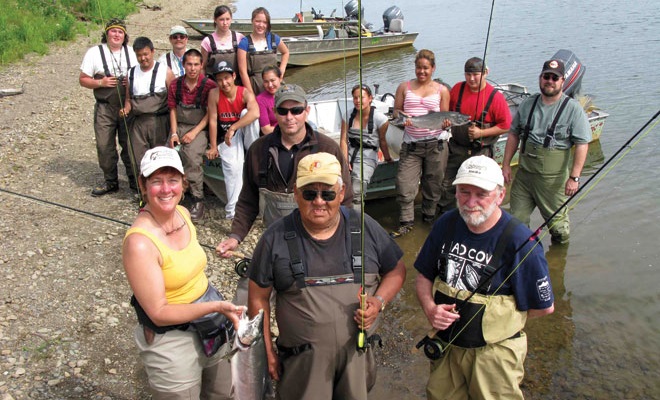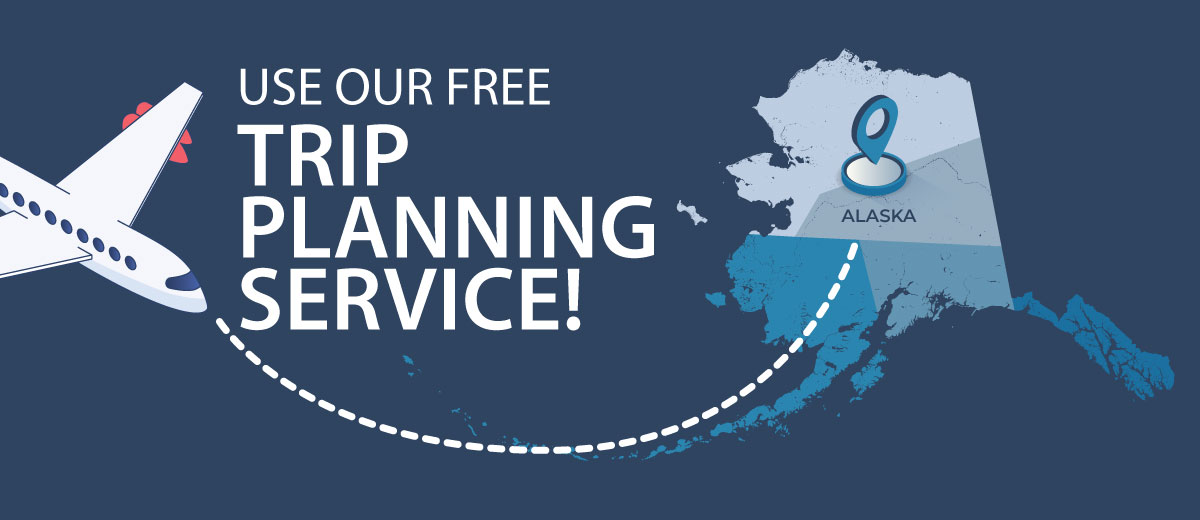Regional Groups Build Resilient Fisheries, Communities Across Alaska
Story By Trout Unlimited Staff

The Bristol Bay Fly Fishing and Guide Academy has trained more than 100 youth from the Bristol Bay region to become flyfishing guides with support of partnership funds and volunteer instructors. © Bristol Bay Fly Fishing and Guide Academy
Nationwide, fish-habitat projects taken on by regional groups called Fish Habitat Partnerships are changing communities for the better through research, restoration, protection, and education. Thanks to a bill passed in 2020, this effective work will have more-secure funding and resilience going forward.
Fish Habitat Partnerships bring sometimes nontraditional partners together like sport and commercial-fishing entities, Native entities, nonprofits, or business and government stakeholders, which all believe in and work together to ensure resilient and vibrant fish habitat and communities. They leverage each other’s strengths and work collaboratively—often with big impacts for fish, people, economies, and habitat.
In Alaska, there are four regional partnerships working in Southeast, Kenai, Mat-Su and Southwest, in addition to two multi-state partnerships—the Western Native Trout Initiative and Pacific Lamprey Partnership. We asked each of the regional partnerships to give an overview of what they’re up to.
What’s unique about your region’s fish habitat and partnership?
Southeast: Southeast Alaska contains thousands of coastal islands within a narrow archipelago bordering the highest coastal mountain range in the world. In this rare, coastal temperate rainforest, productive and nutrient-rich ecosystems and abundant biodiversity allow many types of freshwater and marine fish species to flourish. Additionally, Southeast’s rugged and mostly intact ecosystems afford fish protection from a variety of stressors such as changing climate and urbanization. This region is also home to a “salmon forest,” as salmon return every year to spawn in its streams and lakes, influencing the survival of other species including the magnificent trees within the Tongass National Forest.
Kenai: We cover approximately 25,000 square miles, 14 major watersheds, and over 20,000 miles of stream habitat as well as more than 350,000 acres of wetland habitat. The Kenai Peninsula is one of Alaska’s premier destinations for both residents and visitors and is known for its world-class sportfishing and wildlife viewing. The peninsula’s salmon stocks and resident fish species like rainbow trout, Arctic grayling, and lake trout support vital commercial, sport, and subsistence fisheries, are important sources of food for brown and black bears, bald eagles, marine mammals, and a variety of other animals, and are a key source of nutrients for both terrestrial and aquatic environments.
Southwest: The fish habitat we seek to preserve includes all of Bristol Bay and the Kuskokwim River up to and including the Aniak River. This region supports the largest wild salmon populations on earth and one of the northernmost ranges of rainbow trout.
Mat-Su: The Mat-Su Basin, which is roughly the size of West Virginia, has more than 50,000 miles of rivers and streams. The northern edge is defined by the wilds of the Alaska Range, where a raindrop that falls on the south side of North America’s highest peak, will eventually flow into the Susitna River. The southern portion of the watershed is home to the fastest-growing human population in the state at over 100,000 people. This same place is home to Chinook, coho, sockeye, pink and chum salmon that spawn and rear in Mat-Su waters.
What’s one complete project you/the partnership are very proud of? What were its impacts?
Southeast: While the ecosystems in southeast are largely intact, it does have impairments along road-stream corridors where fish passage is impacted, which we have worked hard to correct. In 2015, the Southeast Partnership received funding to support the Tongass Top Five Fish Passage Design Initiative, highlighting five locations across the Tongass National Forest where fish-passage improvement was needed. Our partners were able to leverage this funding with other opportunities to yield more than 30 fish-passage-improvement designs, many of which have been implemented or are in progress.
Kenai: Stream Watch is a growing, volunteer-based river stewardship and education program we support that operates at the most heavily used recreational and personal-use fishing sites on the Kenai Peninsula with over 100 volunteers annually. Since 2014, volunteers donated 9,900 hours of service, educated 23,750 individuals, removed 24,700 pounds of debris and litter from rivers and habitat, and recycled 835 pounds of monofilament fishing line, in addition to many other projects.
Southwest: In 2008, our partners concluded a 21,000-acre conservation easement for Alaska State Parks along the Agulowak River in Alaska’s Wood-Tikchik State Park to protect a popular rainbow trout stream and a critical sockeye salmon migratory corridor. In that same year, partners started the Bristol Bay Fly Fishing and Guide Academy for the youth of Bristol Bay. The Academy, now in its 12th year, has trained more than 100 youth with support of partnership funds and volunteer instructors.
Mat-Su: We supported an effort led by the Chickaloon Village Traditional Council to restore passage for fish on Moose Creek in the Matanuska River drainage. To service coal-mining operations in the early 1920s, this traditionally important creek was straightened and diked, resulting in the creation of several waterfalls—one of which completely blocked access to nine miles of upstream habitat. Over three years, Chickaloon, with many partners, rerouted Moose Creek back to its original channel, rebuilt complex salmon habitat, and once again made it accessible to salmon. Today, Chinook and coho salmon make their annual run to upper Moose Creek after a more than 80-year hiatus.
What’s one thing on the horizon in your region that Alaskans should watch for?
Southeast: We are funding a data archive effort bringing together scientific assessments and other key information that may help our partners make informed decisions on protecting and restoring fish habitat across the region. Keep a lookout for more details at seakfhp.org.
Kenai: Alaskans should watch for threats to our values, and one of our most collectively cherished values is our shared culture around salmon and pristine landscapes. Population growth, unregulated development, habitat fragmentation, degraded water quality, loss of water quantity, and climate change are all threats faced by fish and fish habitat. Over the past 50 years, we’ve observed significant changes to tree-line decreasing wetlands, and available water. In addition, summer stream temperatures and increased sediment loads in glacial streams harm wild salmon. We are challenged by these threats and will continue work to maintain habitat that supports self-sustaining fish populations.
Southwest: The partnership has funded scientific assessments to provide information to help federal, state and local permitting officials decide whether mining in the headwaters of two major rivers in the region can coexist with salmon. Alaskans should watch for efforts to bring durable protection for critical salmon habitat in Bristol Bay.
Mat-Su: In 2018, a defunct hydroelectric dam was removed from the Eklutna River just northeast of Anchorage, reconnecting seven miles of upstream habitat for five species of wild Pacific salmon as well as Dolly Varden char. The long-term ecological outcomes of the project are to fully restore the river. To achieve this, an appropriate amount of water needs to be released from the diversion dam at the outflow of Eklutna Lake to allow salmon to use the newly reconnected habitat, as well as provide fish passage to Eklutna Lake. The Native Village of Eklutna and other stakeholders are working toward this in the mitigation process for the Eklutna Hydropower Project.
What’s the #1 way a community member can help conserve or restore salmon habitat?
Southeast: Donate to the Southeast Alaska Land Trust, the Southeast Alaska Watershed Coalition or another aquatic habitat conservation partner and specify the funds should be used to support salmon-habitat projects. Having access to non-federal dollars allows our conservation partners a chance to leverage those dollars, often up to three to six times. To learn more, contact coordinator@sealaskafishhabitat.org or visit seakfhp.org.
Kenai: Get involved with our partners. Contact us at coordinator@kenaifishpartnership.org or visit kenaifishpartnership.org to learn more.
Southwest: Donate to the Bristol Bay Heritage Land Trust, the partnership coordinator, and designate the funds for partnership projects. The federal dollars allocated to fund projects through the partnership require non-federal match.
Mat-Su: Ensuring Alaska has healthy fish populations into the future will depend on all of us, not just the scientists, or fishery managers. Supporting and working with local land trusts and watershed groups is very valuable, as is supporting our community leaders in making decisions that balance resource needs with retention of healthy salmon habitat. That is essential to healthy fisheries. Fish like salmon need clean, cool water, enough of it, and free access to a variety of habitats. A few simple steps can have a big impact. There are many other good resources for landowners, developers and individuals through groups like Great Land Trust, Alaska Department of Fish and Game, The Nature Conservancy, and on the partnership’s website at: akfishhabitat.org.
Trout Unlimited Staff
This blog originally appeared as ‘Regional Groups Build Resilient Fisheries, Communities Across Alaska’ in the Conservation column of the February 2021 issue of Fish Alaska.


